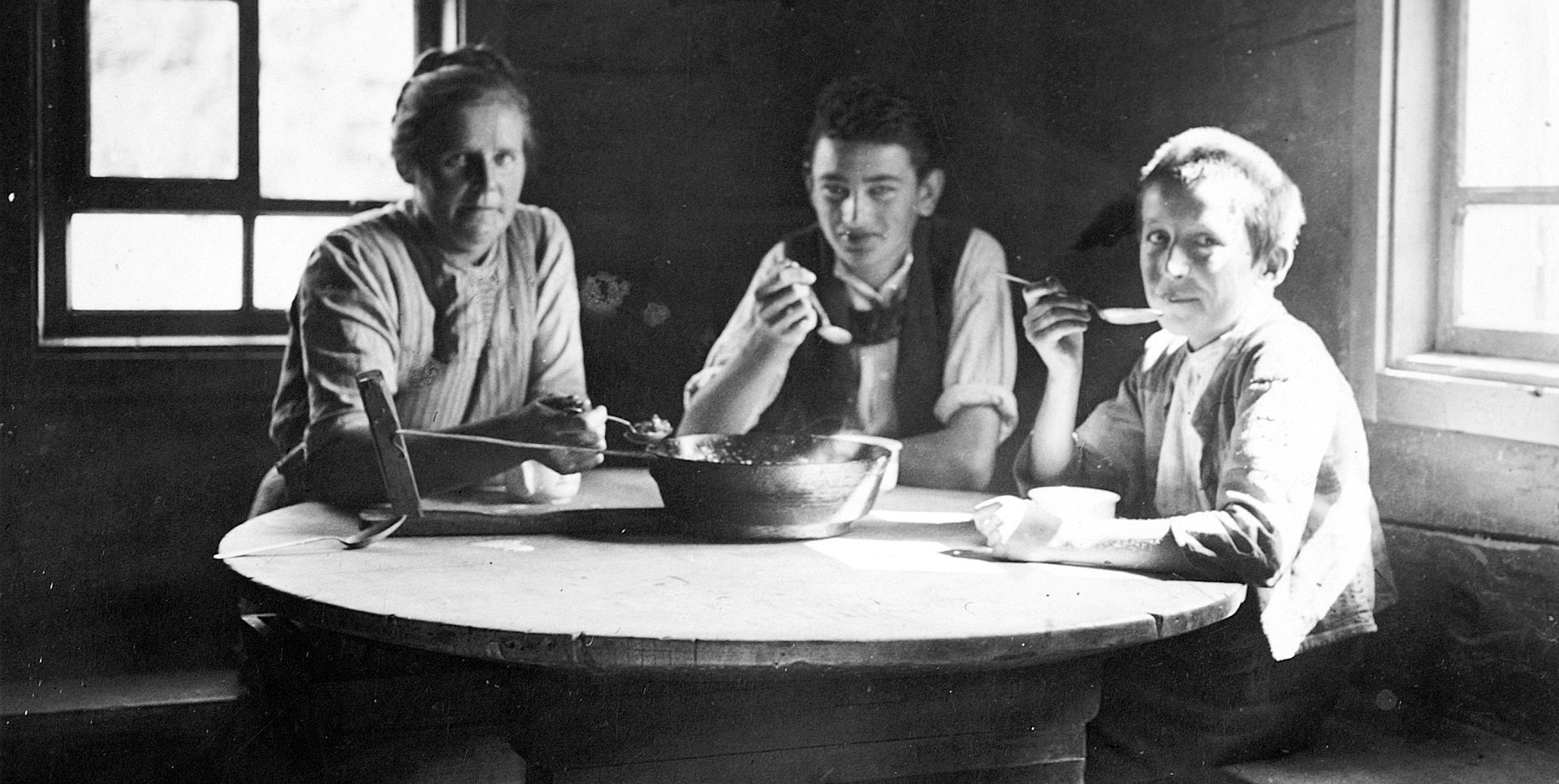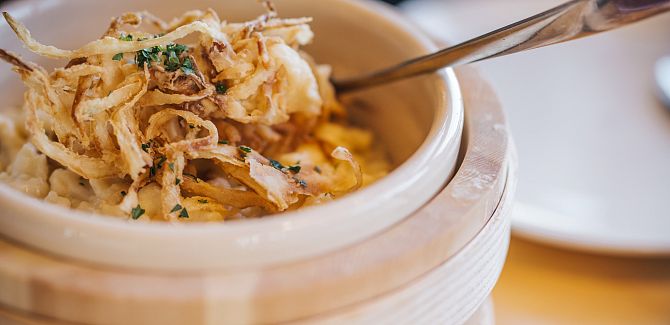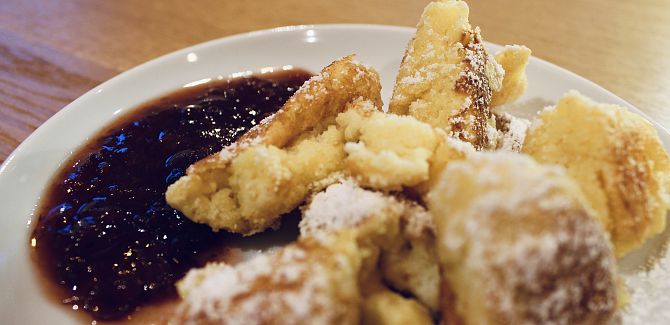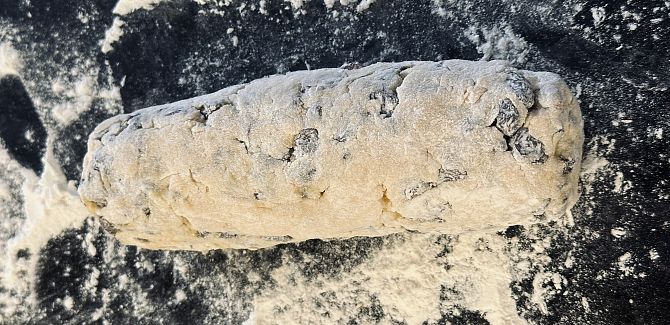
Home cooking with character: Walser classics to fall in love with.
Hidden in the steaming cooking pots of the Walser people is a culinary treasure that has been passed down from generation to generation: traditional Walser cuisine.
Simple to prepare, honest in flavour - and full of stories from days gone by.
Anyone who thinks home cooking is boring will be proven wrong here: from "Riibel" and "diigene Suppa" to addictive "Käsknöpfle" - here you'll find something to fill you up. And happy.
Kääschnöpfle.
Käsknöpfle.

Hardly anyone manages to stick to one - because once you've tasted it, you want more: stringy cheese, golden-brown roasted onions on top and a tasty potato salad to go with it. It makes your mouth water just talking about it!
And did you know? Knöpfle owe their name to their shape - round like a small button. In the past, they were traditionally pressed through a three-legged colander, which gave them exactly this appearance. In contrast, the Spätzle from Swabia are more elongated and noodle-like - they are scraped off the board or pressed through the press. Two regions, two shapes - but one common goal: pure enjoyment.
To the recipe.
"You learn to save from the rich, but you learn to cook from the poor."
Lotschege Chnöpfle.
Beggar's soup.

But the Walser people knew how to help themselves: With some brown roasted onions, fresh mountain chives, a pinch of salt, pepper, nutmeg and grated mountain cheese, it became a warming, hearty soup. It was served with roast potatoes - in true apple slice style. And when there were no more Knöpfle left, a thin Knöpfle dough was prepared without further ado and cooked directly into the soup.
The name ‘beggars’ soup’ is no coincidence - because the beggars also got a taste of it, albeit without the garnish.
"Luam."
- if the food is under-flavoured.
Riibel.
Riebel.
„An Riibel ischt nämmes Guats!“ – (A riibel is something good!) - oh yes, and rightly so!
Quick to make and filling, riibel was once the backbone of simple home cooking - especially in poorer households. No frills, but plenty of substance.
It lives up to its name: Riibel was intended to do one thing above all - fill you up. Lots of hungry mouths, few ingredients? No problem. That's why it's still affectionately known as the "Stopfer" ("Stuffer").

There is the Rahmriebel, which uses fine cream instead of water. Or the potato Riibel, in which potatoes provide the savoury note. If you prefer a fruity flavour, try the apple Riibel with apple pieces or the cherry Riibel with sweet cherries.
The Brännte Riibel - roasted in clarified butter until golden brown - or the Kääsriibel, where the cheese melts seductively, are particularly savoury. And then there's a real rarity: the Riibel with Schmalzgsiig - the flavoursome sediment left over from the production of clarified butter. Simply honest, simply good.
"An Riibel, a Maelsuppa ond gsottne Erdöpfel sött jeeds Mannsbild kocha chönna!"
- Every man should be able to cook Riebel, flour soup and boiled potatoes.

In the past, however, one thing was a must with a ribel: a steaming cup of unsweetened malt coffee.
To the basic recipe.
Kratzed.
Kaiserschmarrn.

There's just one question to answer: with or without sultanas?
To the recipe.

Walser cuisine was down-to-earth, simple - and above all homemade.
What was served on the table usually came from their own garden, the barn or directly from the forest. Potatoes, onions, lettuce and all kinds of cabbage grew right behind the house. In summer and autumn, cherries, pears and apples might be added - sweet treasures from their own orchard.
In the barn, pigs, calves, cattle, goats, sheep and chickens provided meat, milk and eggs. And if you wandered through the woods and meadows, you would rarely find chanterelles and porcini mushrooms in your basket, but more often wild berries. Game such as hare, deer, chamois or stag? That was a rarity.
Haafalaib.
Hafenlaib.

It owes its name to the pot (‘Hafa’) in which it is cooked and its compact shape (‘Laib’). As simple as the name is, as varied are the possibilities - a culinary classic with a down-to-earth flavour and character.
It was served with cabbage potatoes and a barley soup (diigene Suppa), in which boiled meat and the Haafalaib were marinated.
To the recipe.
"Dees hed an Mang."
- when something tastes good to the Walser.
Diigene Suppa.
Walser Suppeneintopf (ähnlich Gerstensuppe).

The dish itself is known in many places simply as ‘barley soup’, but it should not be underestimated: with its savoury ingredients, it really fills you up and warms you up from the inside. And as we all know - a good barley soup always works. And a diigene Suppa from the Walser anyway!
To the recipe.
Beattlmaa.
Bettelmann.

This simple drink used to be a faithful companion when working in the hay: fortifying like a small meal and refreshing enough to quench your thirst. Simple and practical.
Walser menu:
"Es git doch nüt Bessers, wia nämmes Guats scho am Morged,
mit Riibel ond Kaffee ischt ma versorget,
bis ma Späck ond Käs für ds Nüne uf a Tisch richt,
ond wänn´s rächt heiß ischt, chalte Milch drzua triicht.
Uf dr Alp isset ma Sufe ond a chlei Schottagsig drzua,
des ischt nämmes Guats ond bis Mittag he´ma gnua.
Ja, guat Ässa ond Triicha, des git halt Kraft,
Mändle ond Wiible bliba bis i ds ho´ Alter im Saft.
A digne Suppa ond Hafalaib mag ma, ond ischt gsond,
Kääs-Chnöpfle, guat gschmalza, oder sur´ Nudla macha di mit dr Zit halt boda rond.
Zu magera Zita isset ma lotschega Chnöpfle oder as Türkamus us der Pfanna,
Chuddla, Brännsuppa, abgeschmalzne Chränsle im irdena Gschirr us dr Chachelrama.
Bi Wi-Strüble ond Häftchüechle cha ma´s verlida,
zu gsottna Erdöpfl ghört e´gsperrta Käs, da ischt ma z´frieda.
Z´Wiahnachta an saftega Biaraziabl ond a paar Glesle Enzianr drzua,
Zwischetdür amal a Milchbrocheta ond uf´m Gütschle a Ruah.
Öpflchratzed ond Heidelbeermuas ischt mir liaber as wia an rächt gwättna Zopf,
also wer a söttege Spis-Charta net schtimiert, ischt a chlei an einfacha Tropf."
- Hedi Fontain
Source: Adam, O. (o.D.). Walser Kost für Leib und Seel´. Agrar-Verlag Allgäu, Kempten.